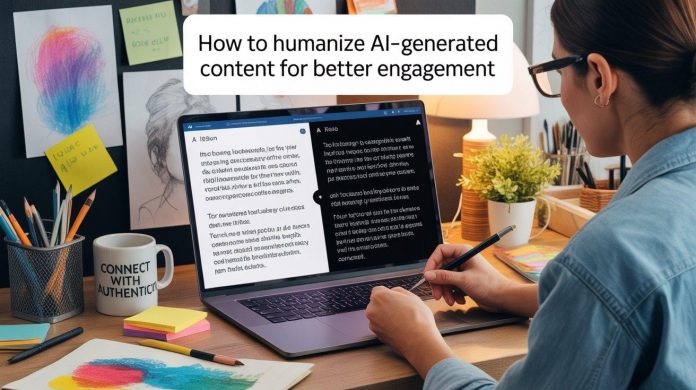Artificial intelligence (AI) is changing the ways we create content. Whether you need to draft blog posts or need to write a social media post, you can use AI tools to generate text. They will help you in crafting the text in seconds, whereas writing manually can take up much of your time.
Yet, the speed that AI tools offer is a huge help, especially for busy professionals. However, there’s also a challenge, which is that AI-generated content sounds robotic and fails to connect with basic readers.
If you have ever generated text using AI tools, you might have observed that the text feels stiff, impersonal, or just a little off. In simple terms, if engagement is the purpose AI AI-generated text might not be a good choice for you.
But, but, but…
By adding a human touch to the AI-generated text, you can transform it into something that truly connects with your audience. Plus, it helps in building trust and drives engagement. In this blog post, you will learn how you can humanize AI-generated content for better engagement.
Why Does Your Audience Prefer a Human Touch?
Before we take you to the ways in which you can humanize AI-generated content, firstly, let’s have a look at why humanized content is preferred. Here’s why adding that personal touch is non-negotiable for building a loyal audience.
It Builds Trust and Credibility
People are more likely to believe something that seems real. An article that sounds like it was written by another human being who gets the subject matter establishes credibility. Robotic text, by contrast, can feel generic and untrustworthy, like it was:
- Cobbled together
- Cut and pasted from a database
A human voice tells them that there’s someone informed on the other side of the screen. It makes your readers feel more confident about the information you share.
It Creates an Emotional Connection
Humans share feelings and experiences. Content that is strictly formal and doesn’t communicate passionately and emotionally can be dry and forgettable.
When you humanize your writing, you reach out to them with their emotions, and they feel listened to and respected. This emotional connection makes the reader a fan of your work. In fact, readers will be more prone to liking content and sharing it while returning for more.
It Improves Readability and Relatability
AI content can be a little dense, less readable than the best of human-authored work. It may contain language that is overly formal or awkward, and that’s likely to make it a turn-off for readers.
Regarding humanized text:
- It makes complex explanations simple
- Speak in a conversational tone
- Transform the material with relatable examples
These things make content that’s more fun and digestible, which is so necessary when you’re fighting to keep your audience entertained.
Ways to Humanize AI-Generated Content
So, now you know why you need to humanize AI-generated content. Now we are going to share the ways that can help you humanize AI-generated content.
1. Use an AI Humanizer Tool
One of the quickest ways to humanize AI-generated content is by using tools like Humanizer Pro. This tool is trained to process AI-generated text and make it more, well, human-written. It will help you rephrase and re-tone sentences. In fact, it smooths out the overall flow so your text doesn’t sound like it was written by a machine.
You can check out Humanizer Pro here.
Think of it as a first-pass edit that quickly polishes the robotic edges.
2. Add Personal Stories and Examples
Nothing resonates with readers like a personal story. AI has no life experience to fall back on, so you’re going to need to add in elements such as:
- Anecdotes
- Real-life stories
- Case studies
If you’re writing about productivity tips, for instance, share a story of the time. A story that you used to be paralyzed by procrastination. Or a technique that has transformed the way you get things done. These personal touches make your content different and show your readers that you’ve been there.
3. Adjust the Tone and Style
AI generally has a tendency towards writing in the formal too; in fact, sometimes it becomes overly formal. To avoid a robot-like copy, you can just adapt your text depending on what you are promoting, and also to the brand or even the audience.
Or,
Maybe you want to come off as friendly and casual?
Perhaps authoritative and professional?
So, to make your AI generated content humanized for better engagement try:
- Using contractions
- Ask direct questions
- Adopt a comfortable tone
This will help your writing to have a more distinct personality.
4. Show Empathy
Your readers are seeking solutions to their problems. Demonstrate that you comprehend their challenges by addressing the pain points they face head-on. For example, you might begin a section with something like, “If you’ve ever found yourself overwhelmed by …”.., you’re not alone.”
When you can show that empathy, you open up a stronger connection and make it more likely that you brand yourself as someone who isn’t just information, but rather something helpful.
5. Create Smooth Transitions
AI-generated text can also seem disjointed, with ideas that fail to follow one from another. When revising, work on smoothing transitions from one paragraph or section to the next.
Include transition words and phrases (such as however, in addition, or on the other hand) to help your readers understand aspects of your argument. It is a far easier and more pleasurable read if the piece is well-structured with a natural progression.
6. Fact-Check and Edit Thoroughly
AI tools, not all but some of them, occasionally produce wrong information or make grammatical mistakes. That is why you should cross-reference every piece of data, statistic, or claim from the AI draft. Additionally, do a really good edit and make sure you didn’t type any wrong words or awkwardly use words or repeat the same sentence.
Sum Up
All in all, AI tools can save you time, but only humanizing it makes your content worth reading. By utilizing the six ways we shared in this post, you can turn stiff text into something relatable and human. Always remember, readers connect with people, not machines. So, try the ways mentioned above and start humanizing your content.






